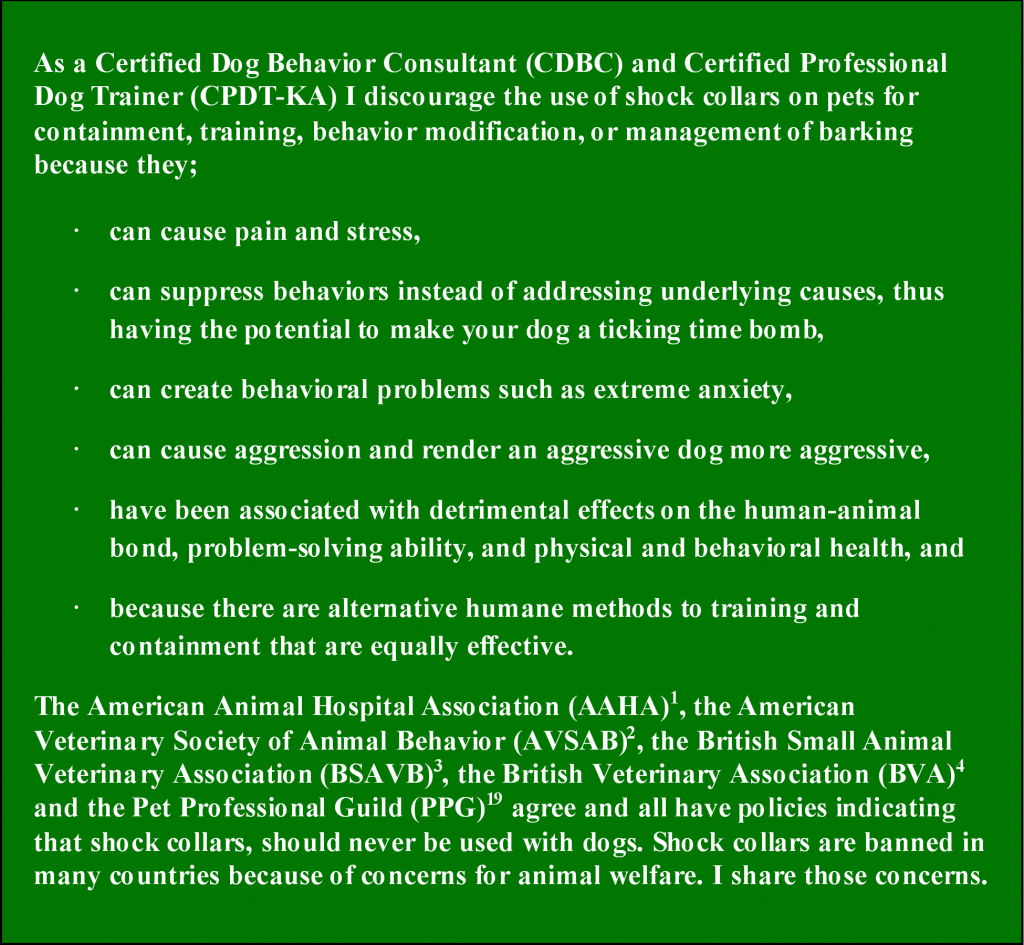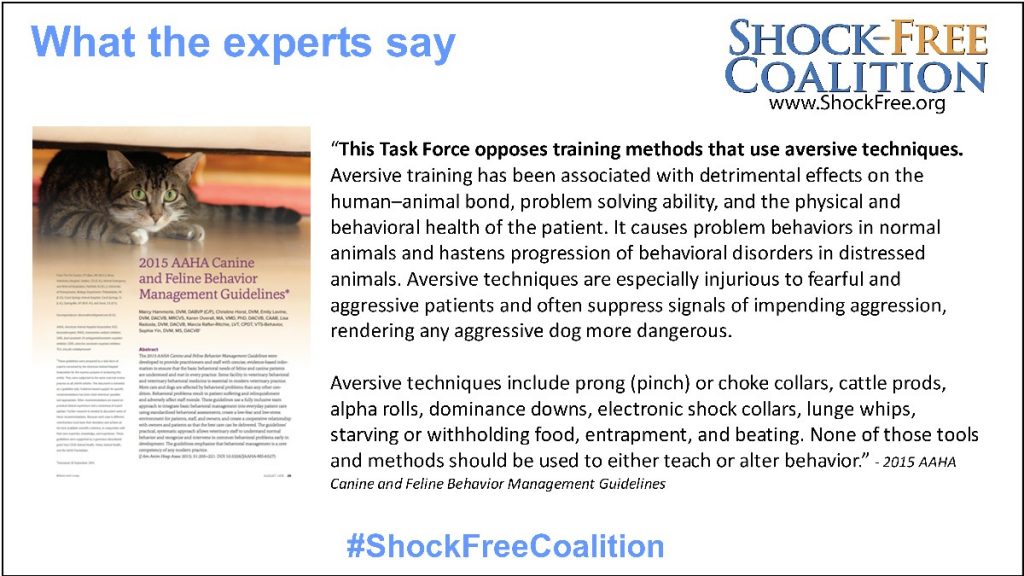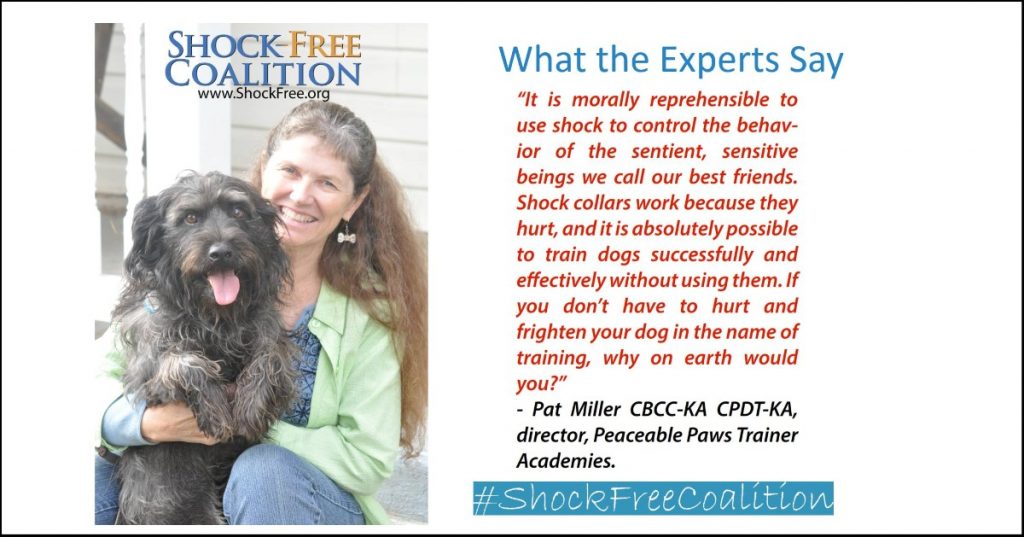< Updated 22OCT17 >
< To view this article as a PDF, click here >

< On October 28th Don and Kate discussed this topic on The Woof Meow Show. You can listen to that show by clicking here.>
What Is A Shock Collar?
A shock collar looks like a standard collar that has a small box with two metal electrodes attached to it. The collar is designed to be worn around the dog’s neck. The collar is fit on the dog, so the electrodes penetrate the dog’s fur and press directly against the dog’s skin. When activated, there is a potential of 1500 volts to 4500 volts across the electrodes, which delivers a painful electrical shock to the dog5. Some collars may even operate at higher voltages. Unfortunately, it is impossible to confirm voltages because manufacturers are very secretive about the amount of voltage their systems apply. In addition to shocking your dog, these collars can cause burns, something we have observed on dogs wearing these devices.
Currently, there are three types of shock collars in use; 1) underground/non-visible fence containment collars, 2) remote training collars, and 3) anti-bark collars. The manner in which the collars are activated varies with the type of collar.
Underground fence containment systems administer a shock to the dog when they approach or cross a buried wire. Typical collars emit an audible warning tone or beep as the dog approaches the wire and ideally, the dog will stop upon hearing the warning tone and will not get a shock. However, if the collar is to be effective at all the dog will need to be shocked at least once, and typically many times if the collar is to be effective. During the training phase with this type of shock collar, small flags or some other visual indicator are supposed to be placed in the ground making the invisible border visible.
Remote training collars utilize a transmitting unit, held by the person. By pressing a button on the transmitter, the person can deliver a shock to the dog from a distant location. A warning tone may sound before the shock. The shock is used as a form of positive punishment (the dog is shocked when it does something the person does not want). For example: if a dog were chasing the neighbor’s livestock it would be shocked in the hopes of stopping the behavior. Remote shock collars are also used for negative reinforcement (the dog is shocked continuously until it exhibits a desirable behavior). For example: if a dog does not come when called it would be shocked continuously until it returned to the handler. People typically use these collars for treating behavioral problems (chasing livestock/predatory behavior, poor recall) and in dog sports such as field trials and hunting. There are even dog trainers that advocate the use of a shock collar for training typical pet dog behaviors such as sit and stay.
Anti-bark shock collars work by detecting when the dog barks and then administering an electric shock as a form of punishment, in theory, stopping the dog from barking.
Scientific Evidence Outlining the Concerns with the Use of Electric Shock
There is no doubt that shock collars cause pain. While proponents might call it a “stim” a “tap,” or a “static charge” we know from the science of operant conditioning that the aversive stimulus (electric shock) must be sufficiently distressing (i.e., physical or emotionally painful) to cause a change in behavior.
Multiple studies6,7,8,9 have reported that shock collars cause undue stress on a dog. A study of guard dogs6, specially bred for toughness and low sensitivity to pain and stress, found that training with shock collars caused long-lasting stress effects to the point that the dog continued to associate their handler as aversive even outside of a training context. The dogs exhibited behaviors associated with fear and anxiety long after they had received shocks. The scientists conducting this study stated: “The conclusions, therefore are, that being trained [with electric shock] is stressful. That receiving shocks is a painful experience to dogs, and that the dogs have learned that the presence of their owner (or his commands) announces reception of shocks, even outside of the normal training context.”
Another study7 examined the use of shock for training to stop undesirable hunting/chasing behavior. This study also revealed the dogs found being trained with shock to be very stressful. The authors concluded, “…the general use of electric shock collars is not consistent with animal welfare.”
A third study8 compared the features of several shock collars and examined how they are used by typical pet owners. The researchers concluded “for a subset of dogs tested, the previous use of e-collars in training are associated with behavioural and physiological responses that are consistent with significant negative emotional states; this was not seen to the same extent in the control population. It is therefore suggested that the use of e-collars in training pet dogs can lead to a negative impact on welfare, at least in a proportion of animals trained using this technique.” (p4).
The scientists conducting this study8 also observed that the instruction manuals that came with these products did not explain features well. When the individuals using the collars were interviewed they could not explain how to use the collar properly and often indicated that they had failed to read the instructions or ignored them. The researcher’s conclusion: “…some of the reported use was clearly inconsistent with advice in e-collar manuals and potentially a threat to the dog’s welfare.” (p25)
As noted in this study, misuse and inappropriate use of shock collars are not uncommon. One of Green Acres’ staff witnessed such abuse at a field trial event right here in Maine. A dog owner with two dogs was working with one of his dogs and had a second dog in his truck in its crate. The dog that he was working with did not respond to a command, so the owner pressed a button on the remote to shock the dog. The dog still did not respond to the command, so the owner shocked the dog again. Meanwhile, the dog in the crate was yelping each time the owner was intending to shock the dog he was allegedly training. It was not until our staff member pointed it out that the owner realized he was shocking his dog in the crate and not the one he was working with. It would seem that the owner had picked up the wrong remote unit.
Because of the findings of “Studies to assess the effect of pet training aids, specifically remote static pulse systems, on the welfare of domestic dogs”8 scientists initiated a fourth study; Studies to assess the effect of pet training aids, specifically remote static pulse systems, on the welfare of domestic dogs; field study of dogs in training9. This study was designed to investigate how dogs would react when a shock collar was used per the manufacturer’s instructions. The study looked at three different groups of dogs; all with owners that had reported their dog either had a poor recall or chased cars, bicycles or animals. One group of dogs was trained with a shock collar by dog trainers that had been trained by shock collar manufacturers; the second group of dogs was trained by the same dog trainers but with positive reinforcement. The last group of dogs was trained by members of the UK APDT (Association of Pet Dog Trainers) using positive reinforcement. The conclusion of the researchers: “…the study did find behavioural evidence that use of e-collars negatively impacted on the welfare of some dogs during training even when training was conducted by professional trainers using relatively benign training programmes advised by e-collar advocates.” The study also demonstrated that the shock collar was not any more effective at resolving recall and chasing behaviors than positive reinforcement training. This supports another recent study10 that concluded: “more owners using reward based methods for recall/chasing report a successful outcome of training than those using e-collars.”
You can read a summary of two of these studies8,9 at http://www.companionanimalpsychology.com/2013/06/the-end-for-shock-collars.html
Shock Based Containment Systems
We believe that individuals that choose underground fence systems for containment are not intending any ill will towards their pet; in fact, it is often quite the opposite. People want to give their pet as much room to run as possible, and they believe that an underground containment system allows for more “freedom” at less financial cost. The problem lays in the lack of understanding about the pitfalls of this type of containment system and the lasting harm that may come to the dog.
In our experience, shock collar systems, where a dog hears a beep followed by an electrical shock at their neck if they continue across the boundary line of your property, create a false sense of security for dog owners and often cause a dog to become fearful and anxious, especially towards other people. The false sense of security comes from the fact, as many have observed, the non-visible fence does not always keep the dog on their property. A dog can see, hear and smell beyond the invisible line buried under the ground and may be attracted to something on the other side of the line causing them to blast through the “fence,” resulting in their getting a shock. If the dog wants to return to its yard, it must now suffer a shock to do so. In other words, there is no incentive to go back home but an intense motivation to stay away.
Additionally, these containment systems do nothing to prevent others dogs, animals or people from entering into your yard. A regular fence has a much higher probability of keeping a dog in and keeping others out, thus ensuring the safety of your dog.
People also tend to think that since there is a containment system in place; their dog can be left alone in the yard. They leave their dog unattended, even though most of the manuals for these systems explicitly indicate you should remain with your dog at all times as they are not a substitute for a reliable fence. Containment systems using electric shock do not offer you the same level of freedom as a conventional fence.
Electric shock causes anxiety in a dog because it hurts. The cause of that pain is then often associated with what the dog was focused on at the time the shock occurred. This could be something totally benign such as; another dog, a neighbor’s cat, a person or someone’s child passing by your yard. For example, if a dog sees your neighbor’s child, runs toward it intending a friendly greeting, and in its excitement crosses the invisible line and is shocked, it is quite likely that your dog will associate this pain with the child. Your dog may now feel anxious and possibly aggressive towards all children. The same can happen towards adults as well as other animals. (See How Does Pain Cause Aggression- Case #1 below for a real example)
While dogs do not always get the shock, sometimes they just hear the beep, that uncertainty in itself can create even more anxiety. If you are from the Midwest you can relate; the anxiety starts when the tornado sirens go off whether the tornado happens or not.
If people approaching the dog cause the dog to get a shock, or even just a beep (a reliable predictor of a shock or the system would not work) and the dog has nowhere else to go (the fence essentially traps them in their yard) then the dog is going to do everything possible to drive those people away – including taking an aggressive posture which may increase the probability of creating a dog with territorial aggression.
Other factors to consider are how your dog will feel about their yard, the space you have designed to give them “freedom.” Sadly I have consulted with clients where the experience of being shocked in the yard causes the dog to refuse to go into the yard. Even more distressing, I have worked with clients where the dog now trembles in terror anytime it hears a beep that sounds anything like the beep of the shock collar (e.g., your mobile phone when you get a text, the smoke alarm when the battery is low, or a kitchen timer when it goes off). The beep even without the shock can and does cause anxiety.
Lastly, like most pieces of technology, shock collars can malfunction. I know of people that have used shock based containment systems where the battery has stopped working which means the collar will no longer beep or shock. More frightening, I have been told of cases where the collar has malfunctioned resulting in the dog being shocked continuously until the battery dies.
The companies that design, manufacture and sell these shock collar systems are unregulated and are primarily interested in profit. They are under no regulatory obligation to report problems that have already occurred. If you do report problems to the manufacturer, you will likely be told you did not follow the directions properly.
Since these products are not regulated, we have no idea how many problems have occurred or how severe those problems have been. While these companies claim their products give pets more freedom, keep pets safe and even save pets lives, these claims are not supported by published scientific evidence. In fact, the evidence in the peer-reviewed literature on the subject of shock collars suggests the exact opposite.
Some people argue that using an underground fence to contain their dog gives the dog more freedom. Dr. Karen Overall, a veterinary behaviorist answers that argument like this: “It’s a myth that invisible fences provide dogs with more freedom. In fact, these devices violate the principles of three of five freedoms that define adequate welfare for animals: Freedom from pain, injury, and disease, Freedom to express normal behavior and Freedom from fear and distress.”11. The five freedoms Dr. Overall has mentioned are Brambell’s Five Freedoms – a standard for assessing animal welfare since the 1960’s12.
Alternatives to using a containment system based on electric shock include; a real fence, a small fenced kennel area on your property, and more frequent walks/exercise with your dog – something that that would be good for both you and your dog.
Shock Collars for Remote Training
Electric shock via remote control is used to positively punish (a momentary shock to decrease behavior) or negatively reinforce (an ongoing shock to increase a behavior) a dog.
Our own experience in dealing with dogs that have behavioral issues, as well as scientific research by experts in the field, indicates that using tools that cause pain and fear can actually elicit or increase aggression and other behavioral problems.5,6,20,21 Fear, anger and confrontation are all stressful. Physiologically a dog’s body will react in the same manner as a human’s when stressed. Stress causes an increase in the hormone cortisol as well as other biochemical changes.13 Studies completed in Japan and Hungary in 2008 demonstrated that dogs that were strictly disciplined had higher levels of cortisol and that these increased cortisol levels were linked to increased aggressive behavior. The many adverse effects of using punishment led The American Veterinary Society of Animal Behavior (AVSAB) to publish guidelines on the use of punishment in training in 2007.2
While punishment can temporarily stop a behavior, it often causes new and additional problems. A study published in Animal Welfare by E.F. Hiby in 2004 concluded that dogs trained with punishment were more likely to demonstrate behavior problems and were less obedient than those trained with positive, reward-based methods.14 Another study, published in the Journal of Veterinary Behavior by Emily Blackwell in the fall of 2008 found that dogs trained with punishment had higher aggression scores while those trained with rewards had the lowest scores for fearful and attention seeking behaviors.15
For a real example of the use of a remote shock collar and its consequences, read How Does Pain Cause Aggression- Case #2 below.
Alternatives to using a remote controlled shock collar include; more effective management of your dog and its environment and a reward-based training program. As for performance sports or working dogs, Green Acres staff and students, as well as many others, have successfully trained dogs for field trials and search and rescue using clicker training and reward based training. Some of the most amazing working animals in the world, those working for the U.S. Navy, have been trained exclusively with reward-based training.
Shock Collars Used for Excessive Barking
Barking is a very normal and very complex behavior for a dog, meaning that there are many possible reasons a dog barks. One of the most frequent reasons a dog barks is due to anxiety. If a stressed dog suddenly receives a painful shock on its neck, it is much more likely to become even more anxious and increase its vocalizing, thus receiving more shocks. These collars cannot distinguish why a dog is barking so just keep shocking away. Because sound triggers them, even another dogs bark can trigger the collar around a dog that is being quiet. For this reason alone, these devices should never be used in multi-dog households or any places with multiple dogs like a boarding or daycare facility. Sadly there are such facilities in our community that use these devices.
The Food and Drug Administration (FDA) is on record stating “Dog collars which are activated by the noise of barking to produce an electric shock are considered as hazardous to the health of the animal.” “Complaints received, which were later corroborated by our own testing, included severe burns in the collar area and possible personality adjustment injuries to the dogs. The shocking mechanism was found to be activated not only by barking but by vehicle horns, slamming doors or any other loud noise.”16
Working with a qualified dog behavior consultant to determine the cause of the barking and to assist in developing a management and behavior modification plan to address the barking will have a higher probability of success.
How Does Pain Cause Aggression?
At some level this seems like a foolish question. I bet that everyone of us can come up with several examples of where we were hurting and not feeling well and were acting rather surly/ Animals are no better or different than us.
The use of positive punishment in the form of choke collars, prong collars, and shock collars can cause aggression. This occurs because the anxiety and pain the dog feels when shocked or choked are often associated with whatever the dog was focusing on at that instant rather than their own behavior. Both real-life cases described below illustrate how using a shock collar created aggression in previously friendly dogs.
Case #1
“Jake,” a very social dog, bounded off to greet every person he saw. Jake’s guardians were concerned about him leaving the yard because he frequently went to visit the neighbor. For what they believed was his protection, the family installed an underground fence system that would keep Jake in their yard. They trained him to the system per the manufacturer’s instructions.
A few weeks after the system was installed, Jake saw the neighbor out in her yard. Since Jake had always liked his neighbor he ran straight for her when he was shocked for crossing the line. This happened a few more times, the once friendly Jake always getting shocked as he ran towards the neighbor. Then one day Jake was inside his home when the neighbor knocked on the front door. When the family opened the door, Jake saw the neighbor and immediately reacted by biting her in the leg.
To Jake, the neighbor was the predictor of the shock, and he now associated the neighbor with being shocked. This incident could have been prevented with the installation of a good, old-fashioned fence or by supervising Jake when he was out in the yard.
Case #2
“Jenny,” would drag her guardians around on her leash, especially when she saw another dog. Jenny was just curious and friendly and wanted to greet the other dogs, but her guardians were older, and Jenny was a strong dog. They had made no attempts to train Jenny and were frustrated with being pulled all over anytime Jenny saw another dog. They went to a big-box pet store where it was suggested they purchase a remote shock collar. They were instructed to shock Jenny whenever she pulled on her leash.
On their next walk, Jenny, as she always had done, moved forward in friendly greeting when she spotted another dog. Jenny was fixated on the dog she wanted to meet when she was shocked. The next time Jenny saw another dog on a walk she immediately became anxious. As the dog approached, Jenny lunged, but this time she also growled and bared her teeth. Jenny had become very afraid and was trying to look fierce to scare the dog away before it hurt her when she was shocked yet again. Jenny, now anxious and confused about other dogs, has learned to become defensively aggressive.
Jenny’s guardians did not train her to stop pulling; all they succeeded in doing is making a previously dog-friendly dog, dog aggressive. If they had enrolled Jenny in a reward based training class or made use of a front-connect walking harness they could have taught her to walk nicely without ever causing her any pain or fear.17
These are not isolated occurrences. I have training colleagues throughout the country that could tell you of similar incidents.
What Do the Experts Say About Shock Collars?
A study published in 20005 looked at five dogs who were subjected to shock collar containment systems and who later bit people, resulting in a lawsuit. No dog had a prior history of displaying aggression towards people, and it is believed that the dogs received a shock at the time of the attack. There is no evidence to suggest that the humans bitten were acting threateningly before the attack. In all cases, the dogs bit the victim repeatedly and uninhibitedly, resulting in serious bodily injury. Other studies on the use of electrical shock on other species, including humans, have noted the extreme viciousness and intensity of shock-elicited aggression.
In their 2015 Canine and Feline Behavior Guidelines, The American Animal Hospital Association says this about aversive training techniques:
“This Task Force opposes training methods that use aversive techniques. Aversive training has been associated with detrimental effects on the human–animal bond, problem solving ability, and the physical and behavioral health of the patient. It causes problem behaviors in normal animals and hastens progression of behavioral disorders in distressed animals. Aversive techniques are especially injurious to fearful and aggressive patients and often suppress signals of impending aggression, rendering any aggressive dog more dangerous.
Aversive techniques include prong (pinch) or choke collars, cattle prods, alpha rolls, dominance downs, electronic shock collars, lunge whips, starving or withholding food, entrapment, and beating. None of those tools and methods should be used to either teach or alter behavior. Nonaversive techniques rely on the identification and reward of desirable behaviors and on the appropriate use of head collars, harnesses, toys, remote treat devices, warps and other force-free methods of restraint. This Task Force strongly endorses techniques that focus on rewarding correct behaviors and removing rewards for unwanted behaviors.” [Emphasis added]

In her book, Manual of Clinical Behavioral Medicine for Dogs and Cats noted veterinary behaviorist Dr. Karen Overall says this about the use of electrical shock for the training of animals.
“To understand people’s willingness to shock their dogs and cats (and sometimes horses), one important association needs to be acknowledged: people reach for tools such as shock when they feel helpless to address their pet’s behavioral concerns and when they feel that this is the only way that they can keep their pet safe and alive. Unfortunately, companies that make and market shock collars prey on these concerns, claiming that their products keep pets safe and save lives. There is no published evidence to support these claims, but there is now considerable evidence published in the peer-reviewed literature that refutes them. Anyone considering the use of shock for behavioral problems— whether it is a remote/ bark activated shock collar, a remote controlled collar, an invisible fence, or a device such as a Scat Mat that shocks anyone who touches it— should know:
- The use of shock is not treatment for pets with behavioral concerns.
- The use of shock is not a way forward.
- The use of shock does not bring dogs back from the brink of euthanasia; instead, it may send them there.
- Such adversarial techniques have negative consequences that are dismissed/ ignored by those promoting these techniques”18 [Emphasis added]

Jean Donaldson, founder and principal instructor, The Academy for Dog Trainers and author of The Culture Clash states:
“Electric shock has no place in modern dog training and behavior management. It is never necessary, and is inhumane and side effect-laden. I know of no valid argument for the continued sale of these devices.”



So What Can You Do To Help Prevent Dogs from Getting Shocked?
 Visit the Shock Free Coalition by clicking on the graphic to the left or at the at the following link https://shockfree.org and educate yourself about why shock collars need to be banned. If you are ready to take the pledge and join us, click on the graphic to your right or on the following link https://www.petprofessionalguild.com/Sign-The-Pledge
Visit the Shock Free Coalition by clicking on the graphic to the left or at the at the following link https://shockfree.org and educate yourself about why shock collars need to be banned. If you are ready to take the pledge and join us, click on the graphic to your right or on the following link https://www.petprofessionalguild.com/Sign-The-Pledge 
Once you signed the pledge download materials from Shock Free Coalition and share them on social media. Get your friends and family members to take the pledge as well. While you’re at it, ask your veterinarian, boarding kennel, doggie daycare, groomer, dog walker, and pet store to take the pledge. Why wouldn’t they?
 If you would like to learn more about what we are doing in the state of Maine visit our website at http://bit.ly/Shock-FreeME or click on the graphic to the left.
If you would like to learn more about what we are doing in the state of Maine visit our website at http://bit.ly/Shock-FreeME or click on the graphic to the left.
As the late Mahatma Gandhi said, “The greatness of a nation and its moral progress can be judged by the way its animals are treated.” Using electric shock on animals is not treating them kindly or effectively. While we recognize both managing and training a dog can be frustrating at times, there is always a better way to deal with a situation than using electric shock.
References
1 2015 AAHA Canine and Feline Behavior Guidelines, American Animal Hospital Association, https://www.aaha.org/professional/resources/behavior_management_guidelines.aspx
2 American Veterinary Society of Animal Behavior, AVSAB Position Statement The Use of Punishment for Behavior Modification in Animals. https://avsab.org/wp-content/uploads/2016/08/Punishment_Position_Statement-download_-_10-6-14.pdf
3 British Small Animal Veterinary Association Position Statement on Aversive Training Methods, http://www.bsava.com/Resources/Positionstatements/Aversivetrainingmethods.aspx
4 British Veterinary Association Policy on Aversive Training Devices for Dog, https://www.bva.co.uk/uploadedFiles/Content/News,_campaigns_and_policies/Policies/Ethics_and_welfare/BVA%20position%20on%20Aversive%20training%20devices%20for%20dogs_PS20JUL2016.pdf
5 Polsky, Richard, (2000), Can Aggression in Dogs Be Elicited Through the Use of Electronic Pet Containment Systems?, Journal of Applied Animal Welfare Science, 3(4), 345-357, http://www.dogexpert.com/wp-content/uploads/2012/05/Electronic-fences.pdf
6 Schilder, Matthijs B.H. and van der Borg, Joanne A.M., (2004), Training dogs with help of the shock collar: short and long term behavioural effects, Applied Animal Behavior Science 85 (2004) 319-334, http://eldri.ust.is/media/ljosmyndir/dyralif/Trainingdogswithshockcollar.pdf
7 Schalke, E., Stichnoth, J. and Jones-Baade, R., Stress Symptoms Caused by the Use of Electric Training Collars on Dogs (Canis familiaris) in Everyday Life Situations, Current Issues and Research in Veterinary Behavioral Medicine, http://www.sciencedirect.com/science/article/pii/S0168159106003820
8 Defra AW1402 (2013) Studies to assess the effect of pet training aids, specifically remote static pulse systems, on the welfare of domestic dogs. University of Lincoln / University of Bristol / Food and Environment Research Agency. Final report prepared by Prof. Jonathan Cooper, Dr. Hannah Wright, Prof. Daniel Mills (University of Lincoln); Dr. Rachel Casey, Dr. Emily Blackwell (University of Bristol); Katja van Driel (Food and Environment Research Agency); Dr. Jeff Lines (Silsoe Livestock System). http://randd.defra.gov.uk/Default.aspx?Module=More&Location=None&ProjectID=15332
9 Defra AW1402a (2013) Studies to assess the effect of pet training aids, specifically remote static pulse systems, on the welfare of domestic dogs; field study of dogs in training. Final report prepared by Prof. Jonathan Cooper, Dr. Nina Cracknell, Jessica Hardiman and Prof. Daniel Mills (University of Lincoln). http://randd.defra.gov.uk/Default.aspx?Menu=Menu&Module=More&Location=None&Completed=0&ProjectID=17568#Description
10 Blackwell et al., The use of electronic collars for training domestic dogs: estimated prevalence, reasons and risk factors for use, and owner perceived success as compared to other training methods, BMC Veterinary Research 2012, 8:93, http://www.biomedcentral.com/1746-6148/8/93
11 Overall, MA VMD PhD DACVB CAAB, Karen, Manual of Clinical Behavioral Medicine for Dogs and Cats, Mosby 2013, location 4757
12 Hanson, Don, APDT Chronicle of the Dog, Fall 2015, Assessing Pets’ Welfare Using Brambell’s Five Freedoms – http://blog.greenacreskennel.com/2014/10/01/animal-welfare-assessing-pets-welfare-using-brambells-five-freedoms/
13 Scholz, Martina, and von Reinhardt, Clarissa: Stress in Dogs, ©2007, Dogwise Publishing
14 Hiby, E.F., Rooney, N.J., Bradshaw, J.W.S., 2004. Dog training methods—their use, effectiveness and interaction with behaviour and welfare. Anim. Welfare 13, 63–69. http://www.ingentaconnect.com/content/ufaw/aw/2004/00000013/00000001/art00010
15 Blackwell, Emily J., Twells, Caroline Anne, Seawright, Rachel A. Casey. 2008. The relationship between training methods and the occurrence of behavior problems, as reported by owners, in a population of domestic dogs. Journal of Veterinary Behavior: Clinical Applications and Research, September/October 2008, pp 207-217. http://www.journalvetbehavior.com/article/S1558-7878%2807%2900276-6/abstract
16 US Food and Drug Administration (FDA), Compliance Policy GuideSec. 655.300 Barking Dog Collar, http://www.fda.gov/ICECI/ComplianceManuals/CompliancePolicyGuidanceManual/ucm074684.htm
17Words, Woofs and Meows – How Do I Get My Dog to Walk Politely Instead of Pulling on the Leash? – http://blog.greenacreskennel.com/2017/04/27/dog-training-how-do-i-get-my-dog-to-walk-politely-instead-of-pulling-on-the-leash/
18 Overall, MA VMD PhD DACVB CAAB, Karen, Manual of Clinical Behavioral Medicine for Dogs and Cats, Mosby 2013, location 4862
19 Pet Professional Guild (PPG) Position Statement on the Use of Shock in Animal Training – https://petprofessionalguild.com/resources/Position%20Statements/Position%20Statement%20on%20The%20Use%20of%20Shock%20In%20Animal%20Training.pdf
20 Bradshaw J.W.S., Blackwell E.J., Casey R.A. 2009. Dominance in domestic dogs – useful construct or bad habit? Journal of Veterinary Behavior: Clinical Applications and Research, May/June 2009, pp 135-144. http://www.journalvetbehavior.com/article/S1558-7878(08)00115-9/abstract
21 Herron M.E., Shofer F.S., Reisner I.R. 2009. Survey of the use and outcome of confrontational and non-confrontational training methods in client-owned dogs showing undesired behaviors. Applied Animal Behavior Science, 117, pp. 47-54. http://vet.osu.edu/assets/pdf/hospital/behavior/trainingArticle.pdf
Recommended Resources
Reward Based Training versus Aversives – http://blog.greenacreskennel.com/2017/04/25/dog-training-reward-based-training-versus-aversives/
The PPG and AAHA – Making A Kinder World for Dogs – http://blog.greenacreskennel.com/2017/04/11/the-ppg-and-aaha-making-a-kinder-world-for-dogs/
How to choose a dog trainer – http://blog.greenacreskennel.com/2017/01/08/how-to-choose-a-dog-trainer/
Please Be Cautious When Choosing Who Cares For Your Pets – http://blog.greenacreskennel.com/2016/04/11/pet-care-services-please-be-cautious-when-choosing-who-cares-for-your-pets/
Selecting A Pet Care Provider – Yes! A Trend Towards Kinder and Gentler Professional Pet Care – Green Acres Kennel Shop’s “Pet Friendly” Philosophy – Part 1 – http://blog.greenacreskennel.com/2015/04/02/yes-a-trend-towards-kinder-and-gentler-professional-pet-care-green-acres-kennel-shops-pet-friendly-philosophy-part-1/
Selecting A Pet Care Provider – Yes! A Trend Towards Kinder and Gentler Professional Pet Care – The PPG – Part 2 – http://blog.greenacreskennel.com/2015/05/02/selecting-a-pet-care-provider-yes-a-trend-towards-kinder-and-gentler-professional-pet-care-the-ppg-part-2/
Podcast – The Unintended Consequences of Shock Collars – http://bit.ly/ShockPodcast
Podcast – The Pet Professional Guild and the Shock-Free Coalition with Niki Tudge – http://blog.greenacreskennel.com/2017/09/27/podcast-the-woof-meow-show-the-pet-professional-guild-and-the-shock-free-coalition-with-niki-tudge/
Podcast –Pet Behavior, Vets & The AAHA Canine and Feline Behavior Management Guidelines – Dr. Dave Cloutier – Veazie Veterinary Clinic – http://blog.greenacreskennel.com/2016/07/02/podcast-encore-pet-behavior-vets-the-aaha-canine-and-feline-behavior-management-guidelines-dr-dave-cloutier-veazie-veterinary-clinic/
The Unintended Consequence of Shock Collars – http://traffic.libsyn.com/woofmeowshow/WoofMeowShow-2014-03-29-Unexpected_Consequences_of_Shock_Collars.mp3
From the Green Acres Kennel Shop Web Site
Press Release – Green Acres Kennel Shop Joins the Shock-Free Coalition – http://blog.greenacreskennel.com/2017/09/25/press-release-green-acres-kennel-shop-joins-the-shock-free-coalition/
Maine Shock-Free Coalition – http://www.greenacreskennel.com/donate/shock-free-coalition-of-maine.html
Green Acres Kennel Shop Position on the Use of Dominance and Punishment for the Training and Behavior Modification of Dogs – http://blog.greenacreskennel.com/2010/07/01/no-pain-no-force-no-fear-green-acres-kennel-shop-position-on-the-use-of-dominance-and-punishment-for-the-training-and-behavior-modification-of-dogs/
Green Acres Kennel Shop Position Statement on Pet Friendly, Force-Free Pet Care – http://blog.greenacreskennel.com/2006/02/01/no-pain-no-force-no-fear-green-acres-kennel-shop-position-statement-on-pet-friendly-force-free-pet-care/
The Shock-Free Pledge – https://www.petprofessionalguild.com/Shock-Free-Coalition
The Shock-Free Pledge (PDF) – https://www.petprofessionalguild.com/resources/No%20Shock%20Coalition/PPG%20Pledge%20Document.pdf
What is shock training – https://www.petprofessionalguild.com/What-is-Shock-Training
Electronic Fences, What You Need to Know – https://www.petprofessionalguild.com/Electronic-Fencing-What-you-need-to-know
Are Electronic Shock Collars Painful or Just Annoying to Dogs? – https://www.petprofessionalguild.com/Are-Electronic-Shock-Collars-Painful-or-Just-Annoying-to-Dogs
What Experts Say – https://www.petprofessionalguild.com/What-Experts-Say
Myths and Misconceptions – https://www.petprofessionalguild.com/Myths-and-Misconceptions
Other Web Articles
Can Aggression in Dogs Be Elicited Through the Use of Electronic Pet Containment Systems? – http://www.leaonline.com/doi/abs/10.1207/S15327604JAWS0304_6;jsessionid=nFup
Training dogs with help of the shock collar: short and long term behavioural effects – http://eldri.ust.is/media/ljosmyndir/dyralif/Trainingdogswithshockcollar.pdf
Association of Pet Behaviour Counselors Press Release on Shock Collars – http://www.apbc.org.uk/article2.htm
Dog Trainer & Author Pamela Dennison on Invisible Fences – https://www.pamdennison.com/why-i-really-hate-electric-sock-invisible-fences/
A scene on shock collars from the documentary Dogs, Cats and Scapegoats – https://vimeo.com/231589923
©2017, Donald J. Hanson, All Rights Reserved <Click for Copyright and Use Policy>
 When we bring a new dog into our home, things do not always work out the way we want. I find that there are two common reasons this occurs; we have unreasonable expectations, or we have been misled.
When we bring a new dog into our home, things do not always work out the way we want. I find that there are two common reasons this occurs; we have unreasonable expectations, or we have been misled.








